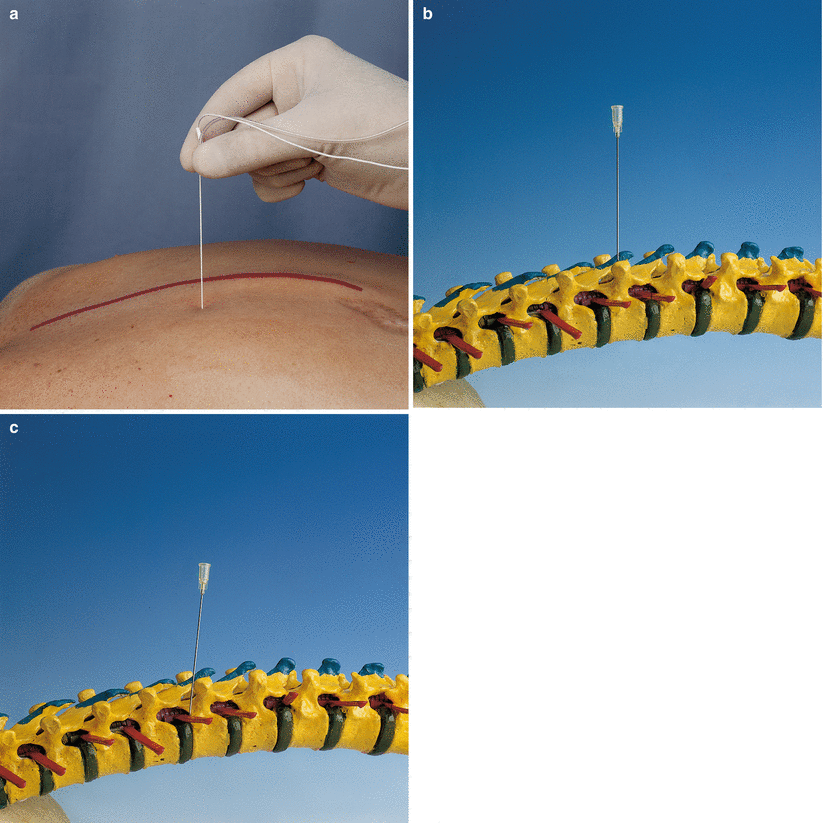Fig. 38.1
(a) Transversal dissection at the level of the T9. (1) Lung, (2) esophagus, (3) aorta, (4) intercostal space, (5) interpleural space, (6) sympathetic trunk, (7) trapezius muscle, (8) longissimus muscle, (9) spinal cord (Reproduced with permission from Danilo Jankovic). (b) Anatomy of the thoracic paravertebral space (Reproduced with permission from www.aic.cuhk.edu.hk/usgraweb [1])
The thoracic paravertebral space contains fatty tissue, the spinal nerves, the dorsal rami, the intercostal vessels, the rami communicantes, and the sympathetic chain. The thoracic paravertebral space is divided in two communicating compartments by a layer of loose connective tissue, the endothoracic fascia which is the deep fascia of the thorax; ventral the “extrapleural” paravertebral space between the parietal pleura and the endothoracic fascia and dorsal to the endothoracic fascia the “subendothoracic” paravertebral space. The sympathetic chain and a fine loose areolar tissue (the fascia subserosa) are located in the “extrapleural” paravertebral space, while the intercostal nerves and vessels are located in the “subendothoracic” paravertebral space.
Technique
Thoracic paravertebral block can be performed with the patient in the sitting, lateral decubitus, or prone position. The thoracic paravertebral block can be performed in an awake patient, under sedation or general anesthesia.
A 18–20-gauge blunt-tipped block needle or a Tuohy needle can be used for block performance.
There are different techniques of performing the thoracic paravertebral blockade: classic landmark-based with or without a “loss of resistance,” pressure monitoring, nerve stimulation, intercostally placed paravertebral catheterization, and ultrasound-guided thoracic paravertebral block. In this chapter, the classic landmark-based technique and the ultrasound-guided thoracic paravertebral block will be described.
To obtain anesthesia or analgesia in more than one dermatome, either a multi-injection technique, where in each adjoining dermatome 4–5 mL local anesthetic is injected, or a single-shot injection technique, where a single 20 mL bolus of local anesthetic is injected at the appropriate level, can be used. It is the opinion of the authors that the latter technique is preferable in order to avoid accidental pleural puncture. In the single-injection technique, 20 mL of local anesthetic consistently blocks five adjoining dermatome levels. It should be noted however that the distribution is preferentially four dermatomes caudal and only one dermatome level cranial with respect to the puncture site. Therefore, the appropriate level to perform a single-injection multilevel thoracic paravertebral block for mastectomy, thoracotomy/VATS, major renal surgery, and unilateral laparotomy is at vertebral body interspace T2–T3, T3–T4, T8–T9, and T9–T10, respectively.
Classic Landmark-Based Thoracic Paravertebral Block
At the level of the appropriate vertebral body, a needle is inserted 2.5–4 cm lateral to the most cranial part of the spinous process (Fig. 38.2a). Subsequently, the needle is advanced perpendicular to the skin in all directions until it contacts the transverse process, which is usually located at a depth of 2–4 cm (Fig. 38.2b).


Fig. 38.2
(a) Introducing the needle perpendicular to the skin surface (Reproduced with permission from Danilo Jankovic). (b) Bone contact (transverse process) (Reproduced with permission from D. Jankovic). (c) The needle is withdrawn to lie subcutaneously and then introduced 2 cm deeper past the transverse process (Reproduced with permission from D. Jankovic)
If no contact is made with the transverse process at this depth, the needle can be located in between two transverse processes; the needle has to be withdrawn and redirected in a more cranial or caudal direction. For safety, it is important that the transverse process is identified in order to minimize the risk of an accidental pleural puncture. After bony contact is made with the transverse process, the needle is withdrawn slightly and the transverse process is slowly walked off in either a cranial or caudal direction until a “loss of resistance” is observed, usually at a depth of 1.5–2 cm from the transverse process (Fig. 38.2c). The observed “loss of resistance” is the needle traversing through the superior costotransverse ligament and is more subtle compared to the definite give in epidural block when the needle traverses the flavum ligament.
If a catheter technique is indicated, the catheter can be threaded 1–2 cm into the thoracic paravertebral space (more than 2 cm will increase the incidence of inadvertent epidural placement).
An alternative to the “loss-of-resistance” technique is the “blind” classic landmark-based technique: after identification of the transverse process as described above, the needle is withdrawn slightly and the transverse process is slowly walked off in either a cranial or caudal direction for 1–2 cm. This “blind” technique is not associated with a higher risk of pneumothorax with respect to the “loss-of-resistance” technique.
During injection, the following points must be observed without fail:
1.
The person performing the injection must stand on the side being blocked.
2.
The injection point must be located within 4 cm lateral to the midline (rib contact, risk of pneumothorax!).
3.
There is a risk of perforating the dural cuff if the injection is made too far medially (epidural or subarachnoid injection).
4.
The transverse process is ca. 0.6–0.7 cm thick.
5.
If there is no bone contact after 2.5–5 cm (depending on the habitus of the patient), the direction of the needle must be corrected (the transverse process has been missed; risk of pleural puncture).
6.



If the patients coughs, it can indicate pleural irritation. The procedure should be halted.

Full access? Get Clinical Tree








